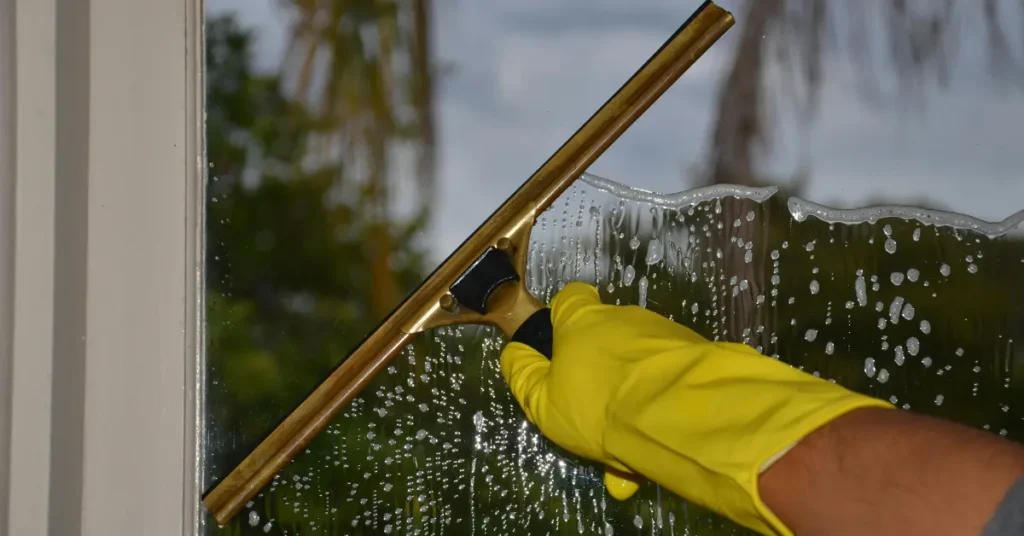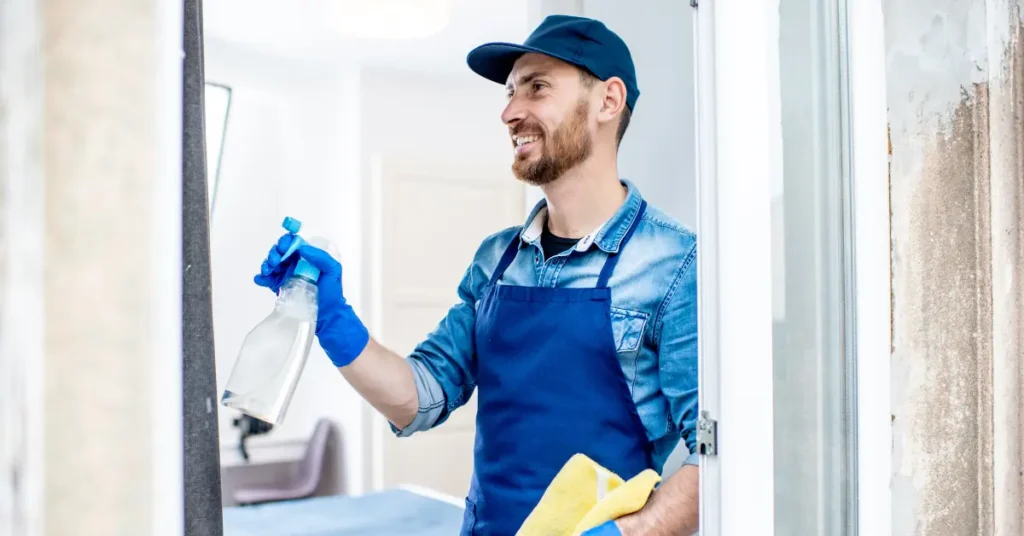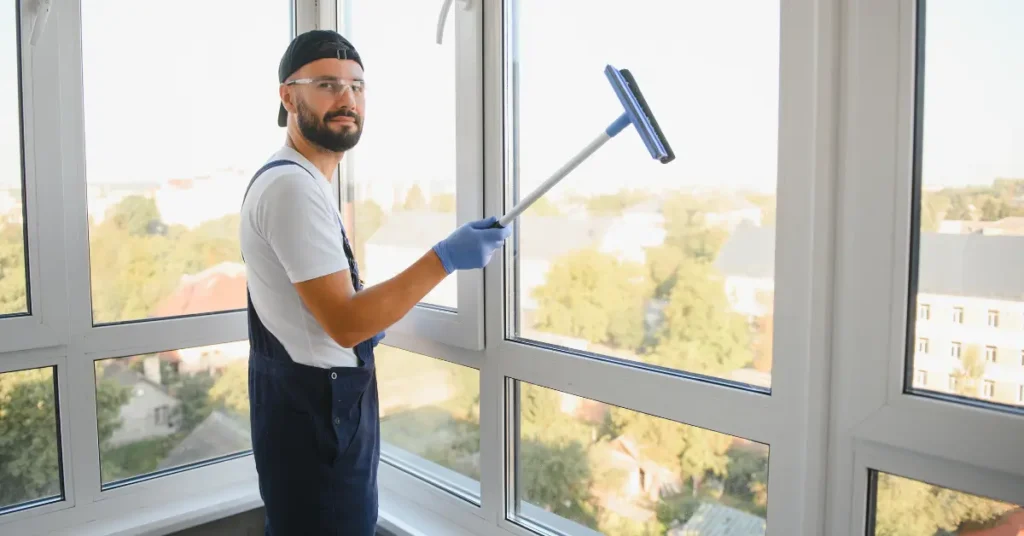Keeping your home’s windows clean and clear makes a significant difference in the appearance and ambiance of your living space. If you’ve ever wondered how to clean windows effectively without leaving streaks, this comprehensive guide will walk you through the process. Window washing doesn’t have to be a dreaded chore. With the right tools, techniques, and schedule, you can maintain crystal-clear glass and a brighter home interior. We’ll cover why window cleaning matters, what supplies you’ll need, a step-by-step cleaning method, safety precautions for hard-to-reach panes, and when it might be best to hire a professional.
Why Regular Window Cleaning Is Important
It’s an essential part of residential window maintenance that protects your investment in your home’s windows. Over time, dirt, pollen, hard-water spots, and other debris can accumulate on glass and frames. This grime not only dulls the appearance of your windows but can also cause gradual damage. Abrasive dirt particles and mineral deposits can etch into glass or corrode window frames if left unchecked. Consistent cleaning prevents this long-term damage, helping your windows last longer and operate smoothly. Additionally, clean windows significantly enhance curb appeal and allow more natural light to enter your home, brightening the interior and even positively impacting your mood.
Essential Tools and Supplies for Window Cleaning
Before diving into the cleaning process, it’s important to gather the right tools. Having the proper supplies on hand will make interior and exterior window cleaning much easier and ensure a streak-free finish. Here are some essentials to have ready:
- Cleaning solution: You can certainly use a commercial glass cleaner, but many homeowners prefer window cleaning solutions without chemicals. A popular DIY option is a mix of equal parts white vinegar and water. This natural solution is effective for cutting through grime without harsh chemicals. Fill a spray bottle or bucket with your chosen solution. )
- Buckets and spray bottles: Have a bucket for mixing the solution and a spray bottle for applying it to the glass. Using two buckets can be helpful. One for your cleaning solution and one with plain water for rinsing your tools.
- Squeegee: A good quality squeegee is the professional’s secret weapon for streak-free windows. Choose one with a rubber blade in good condition. Squeegees come in various sizes; a smaller one (10–14 inches) is great for typical residential windows, while a larger one can speed up work on big panes.
- Scrubber or sponge: Use a handheld sponge or a strip applicator to apply the cleaning solution and gently scrub the glass. Microfiber scrubbers are excellent at removing dirt without scratching.
- Microfiber cloths or lint-free rags: You’ll need some soft cloths for drying and detailing. Microfiber is ideal because it’s lint-free and absorbent. Old cotton t-shirts or crumpled newspaper can also work for drying without streaking. Keep a stack of clean, dry cloths on hand for wiping edges and polishing the glass.
- Extension pole: If you have high windows or second-story windows that can be accessed from the ground, an extension pole that can attach to your squeegee or scrubber is extremely useful. This lets you reach upper windows without a ladder in many cases.
- Additional items: Don’t forget a stable ladder, a window track brush or an old toothbrush, and a vacuum or dustpan to clean up debris from sills and frames. It’s also wise to lay down a drop cloth or towel on interior floors beneath the window to catch any drips.
By assembling these supplies ahead of time, you’ll be ready to tackle the cleaning efficiently. Having the right tools ensures that your home window cleaning efforts will be effective and safe for your windows’ materials.
Step-by-Step Residential Window Cleaning Process
Once you have your supplies, it’s time to get to work. Follow this residential window cleaning process to achieve a streak-free shine on your windows:
- Prep the window area: Start by removing any curtains, blinds, or nearby items that might be in the way. If your windows have screens, carefully remove them and set them aside. Using a soft brush or a vacuum with a brush attachment, gently dust the window panes, frame, sill, and tracks. Clearing away loose dust and cobwebs before you apply any liquid will prevent muddy streaks later. You can also lay an old towel along the sill or floor to catch drips for interior windows.
- Wash the window glass: Generously apply your cleaning solution to the glass. If you’re using a spray bottle, mist the entire pane, or if using a bucket and sponge, dip the sponge and gently wipe down the glass. Ensure the whole surface is wet with cleaner, especially any spots with grime. It’s best to avoid cleaning windows in direct sunlight or when the glass is hot, because the solution can dry too quickly and leave streaks. Choose a cloudy day or work on the shaded side of the house to give yourself more time to properly squeegee off the liquid.
- Scrub gently as needed: For any stubborn dirt or spots, use a little extra pressure with your sponge or a non-scratch scrub pad. You might let the cleaning solution sit for a minute on tough grime to soften it. Never use steel wool or razor blades on the glass, as these can scratch the surface. If you encounter sticky residue, rubbing alcohol on a cloth can help dissolve it.
- Squeegee the glass: Now comes the key step for a streak-free finish. Take your squeegee and, starting at the top of the window, pull it in a smooth stroke across the glass. For best results, hold the squeegee at a slight angle so that only one corner of the blade is contacting the glass at first; this helps direct the water toward the uncleaned area. Wipe the squeegee blade with a clean cloth between each pass to remove excess water and dirt. You can use horizontal strokes or vertical strokes, but be consistent and overlap each stroke slightly to avoid leaving lines. Many people use horizontal strokes on interior windows and vertical strokes on exterior windows; this trick helps you determine which side of the glass a streak is on if you do see one. Work from top to bottom until you’ve squeegeed the entire window.
- Wipe edges and any remaining drips: After squeegeeing, take a clean, dry microfiber cloth and wipe around the edges of the glass where a bit of water might be lingering. Also, wipe the window sill and frame edges to catch any spills. This detailing step will eliminate any watermarks and give a crisp finish. If you notice any streaks on the glass, it likely means a portion of the window still has a bit of dirt, or you missed it with the squeegee. Simply polish that area with your dry cloth or a balled-up piece of newspaper.
- Clean window frames and sills: It’s a good idea to also wipe down the window frames with a gentle cleaner or a simple solution of soap and water. Use a separate cloth or sponge for this task. You don’t want to smear grease from the frame onto your freshly cleaned glass. For wooden frames, avoid soaking them; just use a damp cloth and dry immediately. For vinyl or aluminum frames, a mild all-purpose cleaner or a bit of vinegar and water will remove dust and grime. Pay special attention to the window tracks where dirt accumulates; a small brush can loosen debris, and you can vacuum it out or wipe with a damp cloth.
- Don’t forget the screens: While you may not need to clean your window screens every time you clean the glass, doing so a couple of times a year will maintain clarity and airflow. To clean screens, remove them and gently scrub with a soft brush and soapy water, then rinse with a garden hose. Ensure they are fully dry before reinstalling. Clean screens let more light through and keep dirt from transferring to your clean windows.
Repeat these steps for each window in your home. Many people find it efficient to do all the interior sides first, then tackle the exterior sides, but you can choose whatever order makes sense. With this process, home window cleaning becomes a straightforward task, and you’ll be rewarded with sparkling, clear glass.
Showcase Company Values and Community
Many residential window cleaning companies are founded on strong values that shape not just their work ethic, but their broader impact on the communities they serve. These values often extend far beyond simply delivering sparkling windows. They include commitments to integrity, service, and making a positive difference in local neighborhoods. Charitable partnerships are another hallmark of the window cleaning industry’s dedication to giving back. Several reputable companies form ongoing relationships with nonprofit organizations, supporting causes that align with their core values. These partnerships may involve regular donations, volunteer work, or sponsoring local events, all of which help strengthen the bond between the business and the people it serves.
Community engagement is also woven into the daily operations of many window cleaning businesses. Locally owned and operated teams often participate in neighborhood clean-up days, sponsor youth sports teams, or offer free or discounted services to community centers, schools, or charitable events. These efforts reflect a genuine investment in the well-being and vibrancy of the communities where they work.
Exterior Window Cleaning and Safety Tips
Cleaning the outside of your windows often poses a bigger challenge, especially for upstairs windows. Exterior glass tends to have more stubborn dirt and may not be easily reachable from the ground. Here, safety is paramount. When it comes to interior and exterior window cleaning, the methods are similar, but you must take extra precautions with exterior work. Always prioritize safety when you clean exterior upstairs windows safely without risking injury.
For second-story or hard-to-reach windows, the safest approach is to keep your feet firmly planted on the ground. Use a garden hose to rinse the glass and an extendable pole with a scrubber and squeegee attachment to wash and dry the window from the ground. This telescoping pole method can be very effective. First, spray the window with water to knock off loose dirt. Then, use the pole with a sponge or brush to apply your cleaning solution, scrub the pane, and finally switch to the squeegee attachment to remove the water. Many home improvement stores sell extension window cleaning kits for precisely this purpose. Working from the ground eliminates the dangers of climbing ladders and can usually get the job done for windows on the second floor.
If an extension pole won’t suffice and you need to use a ladder, do so with great caution. Ensure the ladder is sturdy and fully opened on a level surface. It’s wise to have someone act as a spotter, holding the base of the ladder and keeping it stable while you work. Wear shoes with a good grip, and never overreach to one side. Climb down and reposition the ladder instead. Carry a minimal amount of equipment up the ladder. It may be best to clean high windows with a partner: one person can remain on the ground passing supplies or steadying the ladder while the other person cleans. Be mindful of weather conditions when cleaning exteriors. Avoid doing this work on a windy day, as it can make ladder work more hazardous and may blow dirt onto your wet windows. Also, skip high window cleaning in rain or storms for safety. If windows are too high or inaccessible, hire window cleaners rather than taking unnecessary risks. Professionals have specialized ladders, lifts, and safety gear to handle those tricky jobs.
How Often Should You Clean Your Windows?
Now that you have the technique, let’s talk about recurring window cleaning and maintenance. How frequently you clean your windows will impact how easy the job is each time and how your windows look in the long term. In general, regular cleaning keeps the task manageable, since you’ll prevent heavy build-up of grime. As part of your overall window maintenance routine, aim to give your windows attention on a consistent schedule.
For most homes, do a whole-house window cleaning at least twice a year. Typically, once in the spring and once in the fall. A thorough biannual cleaning of all exterior and interior windows helps maintain clarity and catch any issues early. Interior windows usually need cleaning more often than exteriors; the inside glass can get smudged by fingerprints, pets, and indoor pollutants. The key is to maintain a consistent schedule that keeps dirt from building up too much. Mark your calendar or set reminders for window cleaning as you would for other home tasks like servicing HVAC or cleaning gutters. This way, window maintenance becomes a habit, and your home will always benefit from the clear views and sunshine that clean windows provide.
How to Get a Quote or Schedule Service
Requesting a free estimate or scheduling window cleaning services is simple and convenient for homeowners. Most professional window cleaning companies offer an easy online form or a direct phone number on their website. You’ll typically be asked to provide basic information about your home and the services you need. After submitting your details, a representative will contact you to discuss your requirements, address any questions you may have, and confirm a suitable time for your cleaning appointment, making the process quick and hassle-free.
Franchise and Business Opportunities
For those seeking a rewarding business venture, residential window cleaning franchises present a promising opportunity. Many established companies offer franchise programs that provide comprehensive training, marketing support, and access to proven business systems and models.
DIY vs. Professional Window Cleaning: When to Hire a Pro
Cleaning your own windows can be satisfying and cost-effective, especially for single-story homes or easily accessible windows. However, there are situations where professional window cleaning is worth considering. High-rise or multi-story houses, windows in awkward or unsafe locations, and homeowners with limited time or physical limitations might benefit from professional help. Hiring professionals eliminates the hassle of climbing ladders or spending an entire weekend on window chores. It also ensures a high-quality result. Pros have commercial-grade equipment and experience that allow them to work both quickly and effectively.
Experienced residential window cleaners can often achieve a flawless, streak-free result in a fraction of the time it would take an untrained person. Because they show up with all the proper tools (from long extension poles and squeegees to ladders or even lift equipment for very high windows), a crew can clean all the windows in a home efficiently. They also know techniques to avoid common pitfalls like drips, streaks, or missed spots. Professional window cleaners can alert you to any issues with your windows as they work, potentially saving you money on repairs by catching problems early. By using the right supplies and methods on each type of window, a pro can even help extend the life of your windows by preventing long-term damage from mineral build-up or abrasive dirt.
Of course, there is a cost associated with hiring a service. The expense will depend on the number of windows, their size, and your home’s height and layout. Many companies offer residential window cleaning services, ranging from one-time cleanings to periodic maintenance plans. For example, Max’s Cleaning Services provides trained crews for home window washing and even offers a window cleaning package covering all your windows on a set schedule to keep them continually gleaming. In deciding between DIY and hiring out, consider the scope of your project and your comfort level. There’s no shame in getting help. The end goal is sparkling home windows, however you achieve it. Professionals will ensure the work is done safely and thoroughly, allowing you to enjoy the result without any effort.
Customer Satisfaction and Guarantees
The ways companies address customer satisfaction include guarantees and pledges to ensure quality service. These assurances are designed to give homeowners peace of mind, knowing their investment is protected and their expectations will be met. If a customer isn’t completely happy with the results, the company will return to address any issues or offer a full refund. Others pledge to deliver superior service every time, emphasizing professionalism, reliability, and courteous treatment. Insured and bonded staff, prompt arrival, and follow-up calls to ensure satisfaction are also common practices. Such guarantees not only encourage first-time customers to try professional cleaning but also foster long-term loyalty and positive word-of-mouth.
Crystal-clear windows can truly transform the appearance of your home’s interior and exterior. By following these residential window cleaning tips, such as using the right tools, working with effective techniques, staying safe, and keeping to a regular cleaning schedule ,you’ll maintain beautiful, streak-free windows all year round. Not only will your home look brighter and more inviting, but you’ll also be protecting the longevity of your windows through proper care. Whether you choose to tackle window maintenance yourself or occasionally enlist some help from the pros, the effort is well worth it. With clean windows, you’ll be able to fully enjoy the sunshine, the views, and the pride of a well-kept home.
Sources:
- pella.com Pella, 5 Benefits of Window Cleaning. (Regular cleaning prevents damage, extends lifespan, and improves curb appeal/air quality.)
- grove.co Grove Collaborative, Easy Ways to Clean Windows without Chemicals. (Vinegar-and-water or mild soapy water works as a natural cleaning solution without harsh chemicals.)



